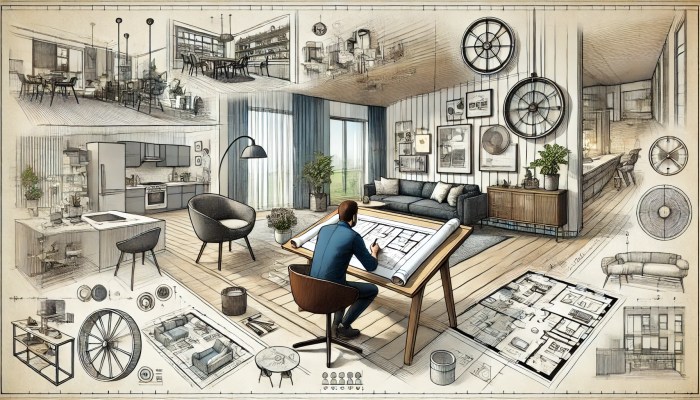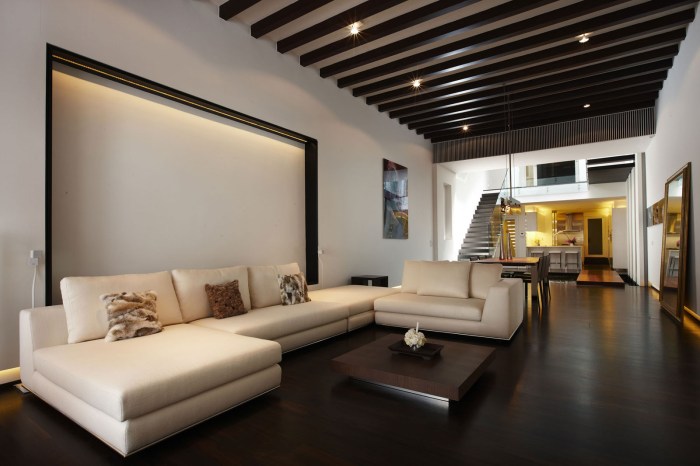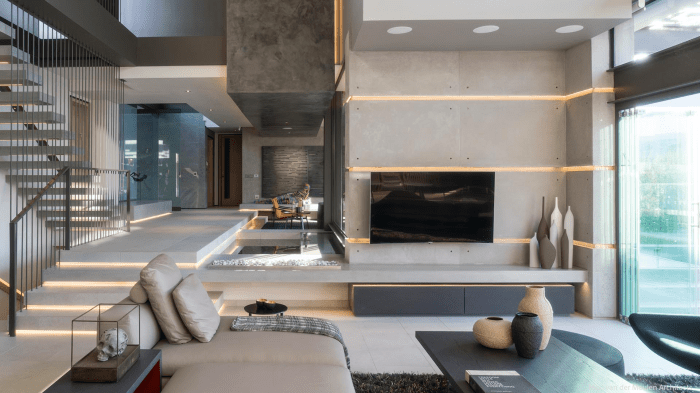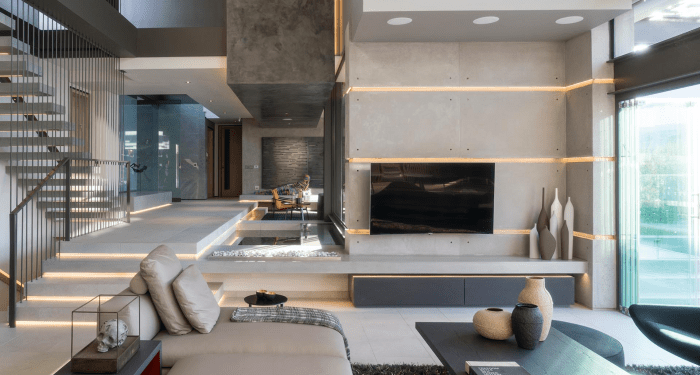Architecture and interior design set the foundation for the narrative ahead, offering readers a window into a world rich in detail and brimming with originality. From the significance of design in shaping our surroundings to the principles that guide the creation of aesthetically pleasing spaces, this topic delves into a realm where creativity meets functionality in perfect harmony.
As we journey through the key elements of architectural design, principles of interior design, and sustainable practices, we uncover a tapestry of knowledge that illuminates the art of crafting spaces that not only inspire but also endure.
Importance of Architecture and Interior Design
Architecture and interior design play a crucial role in shaping our environment, influencing how we interact with spaces on a daily basis. Well-designed structures and interiors can have a significant impact on our mood, productivity, and overall well-being.
Enhancing Mood and Productivity
Thoughtfully designed spaces can evoke positive emotions, reduce stress, and improve mental clarity. For example, natural light, color schemes, and ergonomic furniture choices can create a welcoming and comfortable atmosphere that promotes focus and creativity.
Functionality and Aesthetics
Architecture and interior design work hand in hand to create spaces that are not only visually appealing but also highly functional. From optimizing layouts for efficient use of space to incorporating sustainable materials for a healthier environment, the design choices made can greatly enhance the quality of life for occupants.
Elements of Architectural Design
When it comes to architectural design, several key elements play a crucial role in shaping the overall look and feel of a structure. These elements include form, function, scale, proportion, texture, materials, finishes, lighting, and spatial planning.
Form
Form refers to the overall shape and structure of a building. It involves the arrangement and organization of various elements to create a visually appealing design that is both functional and aesthetically pleasing.
Function
Functionality is a fundamental aspect of architectural design, focusing on how the space will be used and the needs of the occupants. A well-designed building should not only look good but also serve its intended purpose effectively.
Scale and Proportion
Scale and proportion are essential considerations in architectural design, ensuring that elements within a space relate harmoniously to one another and to the overall structure. Proper scale and proportion create a sense of balance and cohesion in the design.
Texture
Texture adds depth and visual interest to a building's surfaces, enhancing the tactile and visual experience. It can be achieved through the use of materials, finishes, and detailing, adding richness and character to the architectural design.
Materials and Finishes
The choice of materials and finishes significantly impacts the overall look and feel of a building. Materials such as wood, glass, concrete, and metal can influence the style, durability, and sustainability of a structure, while finishes like paint, tiles, and fabrics add personality and character.
Lighting
Lighting is a critical element in architectural design that can transform the mood, ambience, and functionality of a space. Proper lighting design enhances visibility, highlights architectural features, and creates a comfortable and inviting environment for occupants.
Spatial Planning
Spatial planning involves the strategic organization of spaces within a building to optimize functionality, circulation, and interaction. Effective spatial planning considers the flow of movement, access to natural light, privacy, and connectivity between different areas, contributing to a well-designed and efficient space.
Principles of Interior Design

Interior design is guided by several fundamental principles that help create visually appealing and functional spaces. These principles include balance, harmony, emphasis, and rhythm. Let's delve deeper into how these principles shape interior design.
Balance
Balance in interior design refers to the distribution of visual weight in a space. There are three types of balance: symmetrical, asymmetrical, and radial. Symmetrical balance involves arranging elements equally on either side of a central point, creating a sense of formality and stability.
Asymmetrical balance, on the other hand, involves arranging different elements to achieve equilibrium through contrast, creating a more dynamic and visually interesting space. Radial balance is when elements radiate out from a central point, like in a circular layout.
Harmony
Harmony in interior design is achieved when all elements in a space work together to create a cohesive and pleasing whole. This can be achieved through the use of similar colors, patterns, textures, and styles throughout a space. By maintaining harmony, a space feels unified and well-designed.
Emphasis
Emphasis is about creating a focal point in a space that draws the eye and creates visual interest. This can be achieved through the use of contrasting colors, textures, or a standout piece of furniture or artwork. Emphasizing certain elements helps to guide the viewer's gaze and adds depth and dimension to a space
Rhythm
Rhythm in interior design is about creating a sense of movement and flow throughout a space. This can be achieved through repetition of elements like colors, shapes, or patterns. By establishing a rhythm, a space feels cohesive and visually engaging.
Significance of Color, Pattern, and Texture
Color, pattern, and texture play crucial roles in interior design. Colors can evoke certain moods and emotions, patterns add visual interest and depth, and textures add tactile appeal and richness to a space. By carefully selecting and combining these elements, designers can create unique and inviting interiors.
Furniture Layout and Accessories
The layout of furniture and placement of accessories can greatly impact the overall design of a space. Furniture should be arranged to promote traffic flow and functionality, while accessories like rugs, artwork, and lighting fixtures can add personality and style.
By paying attention to these details, designers can enhance the aesthetic and functionality of a space.
Sustainable Architecture and Interior Design

Sustainable architecture and interior design focus on creating spaces that minimize environmental impact and promote long-term sustainability. By incorporating eco-friendly materials and energy-efficient design practices, these approaches aim to reduce waste, conserve resources, and create healthier living environments.
Examples of Eco-Friendly Materials
- Bamboo: A fast-growing and renewable material that can be used for flooring, furniture, and decorative elements.
- Recycled Glass: Utilizing recycled glass for countertops, tiles, and other surfaces helps reduce waste and energy consumption.
- Cork: Harvested from the bark of cork oak trees without harming them, cork is a sustainable option for flooring and wall coverings.
Energy-Efficient Design Practices
- Passive Solar Design: Orienting buildings to maximize natural light and heat gain, reducing the need for artificial lighting and heating.
- Green Roofs: Installing vegetation on rooftops to improve insulation, reduce stormwater runoff, and provide habitat for wildlife.
- Energy-Efficient Appliances: Using appliances with high energy efficiency ratings to minimize electricity consumption.
Importance of Environmentally Conscious Spaces
Creating environmentally conscious spaces is crucial in modern design to reduce the carbon footprint of buildings, improve indoor air quality, and promote a healthier lifestyle for occupants. By integrating sustainable practices into architecture and interior design, we can contribute to a more sustainable future for our planet.
Conclusion

In conclusion, the fusion of architecture and interior design offers a canvas where innovation meets practicality, where form and function intertwine seamlessly to shape the world around us. As we embrace sustainable practices and timeless design principles, we pave the way for a future where every space tells a story of creativity and conscientiousness.
Question Bank
How do well-designed spaces impact our mood?
Well-designed spaces can positively influence our mood by creating a sense of harmony, balance, and comfort through thoughtful design elements.
What are some key elements of architectural design?
Key elements include form, function, scale, proportion, and texture, all of which contribute to the overall aesthetics and functionality of a space.
Why is sustainable architecture important?
Sustainable architecture is crucial for reducing environmental impact, conserving resources, and creating healthier living environments for occupants.
How do color and texture play a role in interior design?
Color and texture add depth, character, and visual interest to interior spaces, creating a cohesive and inviting environment.
What are some examples of eco-friendly materials in design?
Eco-friendly materials include recycled wood, bamboo, cork, and low-VOC paints, which contribute to sustainable and environmentally conscious design practices.














